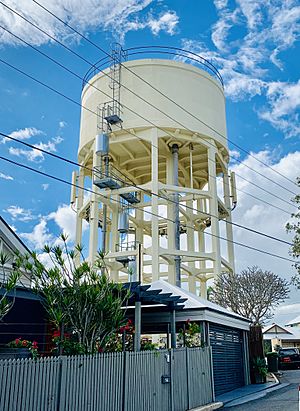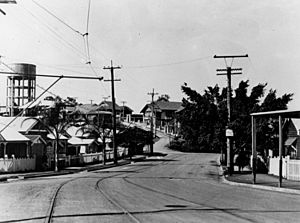Paddington Water Tower facts for kids
Quick facts for kids Paddington Water Tower |
|
|---|---|

Paddington Water Tower, 2019
|
|
| Location | 16 Garfield Drive, Paddington, City of Brisbane, Queensland, Australia |
| Design period | 1919 - 1930s (interwar period) |
| Built | 1927 |
| Architect | Metropolitan Water Supply & Sewerage Board |
| Official name: Paddington Water Tower | |
| Type | state heritage (built) |
| Designated | 23 June 2000 |
| Reference no. | 601831 |
| Significant period | 1927 (fabric) 1910s-1930s (historical) |
| Significant components | pump house, tower - water |
| Builders | day labour |
| Lua error in Module:Location_map at line 420: attempt to index field 'wikibase' (a nil value). | |
The Paddington Water Tower is a special historic building located at 16 Garfield Drive in Paddington, Australia. It's a type of tower that used to hold water. It was designed by the Metropolitan Water Supply & Sewerage Board and built in 1927. This tower is so important that it was added to the Queensland Heritage Register on June 23, 2000.
Contents
A Look Back: Supplying Water to Brisbane
At the start of the 1900s, Brisbane got most of its water from the Brisbane River near Mount Crosby. Water also came from Enoggera Dam and Gold Creek Dam. Back then, the water wasn't cleaned or tested until the early 1900s.
In 1907, an expert named Allen Hazen suggested ways to improve Brisbane's water supply. He advised against building a dam on the Brisbane River because of concerns about mud filling it up. He also suggested other locations for future water storage.
Over the years, from about 1916, the water system near Mount Crosby changed a lot. New buildings were put up, old ones were made bigger, or even taken down. This was all to make sure Brisbane, and later Ipswich, had good quality water.
Why Water Towers Were Needed
It was always tricky to get enough water to homes on high ground. To solve this, many water storage tanks, called service reservoirs, were built in different areas. These included Bartley's Hill (1907, 1919), Enoggera (1912), Holt's Hill (1919), Tarragindi (1923), and Paddington (1927). Other older reservoirs had been built in places like Wickham Terrace and Highgate Hill.
The Paddington Tower's Story
Getting water to the higher parts of Paddington was very hard. So, when the Water Board opened the Paddington Water Tower in 1927, it was a huge help for the people living there. This tower got its water from the Enoggera Dam.
The Water Board had worked for 12 years to get the money needed to build this tower. The tower was officially opened on March 4, 1927. Mr. Ernest James Theodore Manchester, who was the President of the Water Board, led the opening ceremony. Members of the board and local residents were there too. People said the tower was the best project built by any authority at the time. It was also the most expensive single building ever constructed in the Town of Ithaca.
At the opening, the President said that the Water Board always wanted to give a full water supply to everyone on high land. He hoped that in the future, all high areas would have water towers. The electricity for the pump that lifted water into the tank was turned on by Mr. J. J. Roberts. He called Paddington Heights the "Dress Circle of Brisbane," meaning it was a very nice area.
The Water Board's own engineers designed the tower, and the board's staff built it. It stands on a site about 335 feet (102 meters) above sea level. The tank is made of strong concrete and is 70 feet (21 meters) tall. It can hold 100,000 imperial gallons (454,609 liters) of water. The Tramway Department provided the electricity for the pump.
Soon after the tower opened, a small house was built next to it. This was for the "turncock," a person who lived on site to make sure the tank was always full of water.
What the Tower Looks Like
The Paddington Water Tower is located on a piece of land about 529 square meters (5,694 sq ft) on Archibald's Hill. The land slopes down from Garfield Terrace to Tooth Avenue. The tower is close to Garfield Terrace, with the pump house next to its western side.
The Paddington Water Tower is no longer used for water supply. It looks almost exactly as it did when it was first built. It's on Archibald's Hill, making it one of Brisbane's oldest and most noticeable landmarks. It might be the only one of its kind in Queensland. It's a concrete tank lifted up by concrete columns.
Some other old water reservoirs in Brisbane, like those at Wickham Terrace and Bulimba, are also no longer in use.
The Paddington tank and its tower are made of reinforced concrete. The round tank sits on a frame of twelve columns and strong beams. The tower is 70 feet (21 meters) high, and the tank can hold 100,000 imperial gallons (454,609 liters) of water. The top of the water level is 335 feet (102 meters) above sea level.
The tower is a very noticeable landmark in Brisbane's north-western suburbs. You can see it from far away and from many different viewpoints. It's easy to recognize.
Why It's a Heritage Site
The Paddington Water Tower was added to the Queensland Heritage Register on June 23, 2000. This means it's considered an important historical place because it meets certain rules:
- It shows how Queensland's history changed.
The Paddington Water Tower helps us understand how Brisbane's water supply system grew over time. It also shows the challenges of getting water to homes on high ground.
- It's a rare and special part of Queensland's history.
The Paddington Water Tower is a rare example of a concrete water tank built high up. It's likely the only one of its kind in Queensland, with its concrete tank supported by concrete columns.
- It's important because of its beauty and how it looks.
The Paddington Water Tower is important because it's a well-known and easily recognized landmark. It's one of the most prominent landmarks in Brisbane.


